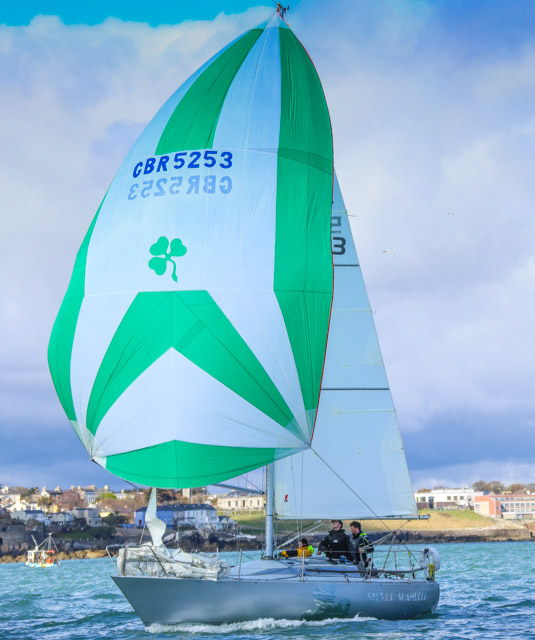Displaying items by tag: Silver Shamrock
The latest addition to Howth’s vintage fleet, Conor Fogerty’s ‘new’ boat is something of an old favourite and one that should be very familiar to Afloat.ie readers.
Silver Shamrock, the Ron Holland-designed and Cork-built Half Tonner that took its class world title in 1976, is still a winner four decades on — putting in a particularly strong showing last summer with then owner and skipper Stuart Greenfield.
But how did Silver Shamrock end up in the hands of Afloat’s latest Sailor of the Year, and ‘come home’ to Ireland? As Fogerty explains it to Afloat.ie, there was more than a little fate involved.
 With a special green Shamrock emblazoned on her spinnaker, the half–tonner competes on Dublin Bay Photo: Afloat.ie
With a special green Shamrock emblazoned on her spinnaker, the half–tonner competes on Dublin Bay Photo: Afloat.ie
“The short story is my partner, Suzanne Ennis, wanted a cruising boat for the family, as Bam! wasn’t ideal,” he says of the Sun Fast 3600 he raced to victory in the 2017 OSTAR.
“[Suzanne’s] father Francis Ennis owned the Club Shamrock ‘Moon Dance’ and her sister Stephanie Ennis and Windsor [Lauden] own the Club Shamrock ‘Demelza’. So the only natural course of action was to follow the family’s love of Shamrocks, but with a twist on the ‘Club’.”
After some research, Fogerty became intrigued about the air of reverence around the yacht Harold Cudmore skippered to the Half Ton World Championship in 1976.
“I knew the owner, Stuart Greenfield, who had been racing her in the SORC; he had saved her from a death of neglect in Falmouth a few years earlier.”
The appeal of a boat like Silver Shamrock was too much to ignore for Fogerty, who started “tyre-kicking a few Golden Shamrocks” in search of the right fit.
But little did he expect that the holy grail herself would pop up for sale on his Facebook feed.
 Silver boat for silver seas – Silver Shamrock is back on Irish waters and contesting coastal races and other Irish fixtures this season Photo: Afloat.ie
Silver boat for silver seas – Silver Shamrock is back on Irish waters and contesting coastal races and other Irish fixtures this season Photo: Afloat.ie
“I flew down to Cowes to meet Stuart and his proudly dry-sailed Shamrock,” Fogerty says. “As Stuart is a neighbour of Harold [Cudmore], I think there was an element of satisfaction in the deal, knowing that Silver Shamrock was returning home after some 40 years abroad.”
And what a return it’s been, as our own Winkie Nixon wrote yesterday of the splash Silver Shamrock has made in her new home waters of Dublin Bay — most recently coming first in class and third over all in the ISORA warm-up race last weekend.
“So to all my ISORA friends: beware of the boat lurking on the horizon!”
“In hindsight, I’m pretty sure, I would rather cruise Bam! than a stripped-out, death-rolling Shamrock,” Fogerty says. “But sure that’s the romantic notion of families sailing versus reality!”
With Bam! currently being shipped back from Antigua after Fogerty’s class win in February’s Caribbean 600 — and sponsorship pending a commitment to the Round Britain & Ireland double-handed race — all focus is now on the Silver Shamrock.
“The plan of action over the next 12 months or so is to train in some crew, modernise her deckware and rig and see if we can get Silver Shamrock back up to her former glory,” Fogerty says of the family cruising project that’s already become so much more.
“So to all my ISORA friends: beware of the boat lurking on the horizon!”





























































